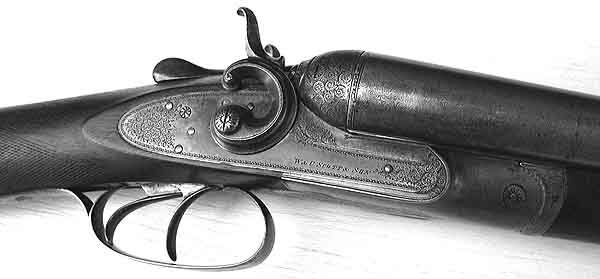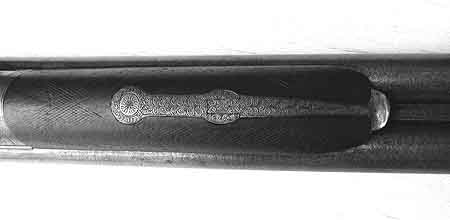Although a number of ‘interesting’ side-by-side shotguns reposed in my gun-safe, they were all hammerless models and just not quite ‘pukka’ for Vintagers-style activities. Some time ago I decided to attempt rectification, and was lucky enough to acquire a well-used but still quite sound W. & C. Scott & Son 12-bore top-lever hammer-gun. The previous owner had been its willing custodian for some 15 years, having originally bought the gun for display on account of the ornate circular hammers. He had finally resigned himself to the fact that the new restrictive firearms legislation was here to stay, and rather than let this fine firearm languish in the back of his gun-safe, he had decided to pass it on to greener pastures.
This particular Scott gun is named “The Victoria”, which I remembered seeing advertised in a collector’s catalogue from early last century. A drawing from that very catalogue was used by the late Geoffrey Boothroyd to accompany his notes on this maker in the book “Sidelocks and Boxlocks”, though he made it clear that at the time he had never seen a “Victoria” and sought confirmation of its existence from his readers. The illustration shows a rectangular cross-bolted gun fitted with ‘Webley Special Steel’ barrels, however the specimen now in my care is apparently a much earlier gun wearing damascus barrels devoid of any form of rib extension. Those graceful, circular hammers are identical, however, and were obviously a hallmark for this particular model.

Inside the barrels, a light peppery pitting, although heaviest towards the breech, did little to detract from the perfectly sound bores, and I was quite relieved to find no cause for alarm there. Despite the inherent risk, I had bought the gun based solely on a description over the phone! The prior owner’s assurances that the gun was tight were rather less well founded however. It was scandalously loose! Like many of these old hammer-guns in Australia, it had probably been fed a steady diet of ‘Impax’ and ‘Blue Star’ over the decades! Nevertheless, a three-thou brass shim on the hinge-pin restored that comforting ‘clonk’ on closing, and will have to suffice until I can see my way clear to fitting a replacement pin or restoring the hook.
One of the nicest features of this double gun is the fore-end latch. During the ‘Golden Years’ of shotgun development, a proliferation of invention resulted in some 29 patents for fore-end fasteners registered in Britain alone! This particular gun is fitted with a latch of the firm’s own design, patent No. 615 granted to William Middleditch and Martin Scott in 1876. A hinged lever is situated under the forward part of the fore-end, terminating in a finger grip. Moving the lever downwards retracts a small sliding bolt from its engagement with the loop, and the fore-end can be swung downwards and removed in the normal manner. The lever was obviously given the full attention of Scott’s best engraver at the time, and displays complete coverage of fine scroll.

The fences and top-lever are also fully engraved with fine scroll, reminiscent of some of Gibbs’ best guns. The lock-plates are somewhat less opulent, with about 40% cover in a pleasing ‘fore-and-aft’ pattern. Traces of the original case colours are still visible on all unadorned surfaces. A gold inlaid 8-point star is a feature of the concave game-rib, along with the proud inscription “W. & C. Scott & Son ( The Victoria ) Makers & Patentees, London”. Scott’s trade-mark ‘tower’ on both the action flats and the ornately engraved trigger-guard tang adds a nice touch. Regrettably, the wood is rather down in condition, with very little of the original checkering remaining, and an abundance of minor dings and scratches. Beneath the old oil, however, there is an enticing hint of fine figure, so a future stock re-finish will have to be added to the list!


Well, I had bought this gun to shoot! Despite the assurances of some gun-writers, there was no way I would entertain the idea of loading 2 ¾ inch cartridges in the original chambers. My trusty shot-shell press could not be made to load 2 ½ inch cartridges without permanent modification, so an old reloading tool manufactured before the first war was once again pressed into service on cut-down plastic hulls. Wad components were initially sourced from a couple of like-minded individuals in Darwin, one of whom regularly entertains us at the traps with an Ekins-retailed under-lever gun. His recommended load was an ounce of shot over 70 grains of 2F for clay targets, adding up to 12 more grains of powder for the serious business of causing feathers to fly!
Before long I was watching a skein closing the distance on a perfect flight-path over my position, and at the opportune moment I rose out of the reeds and swung through the big black-and-white bird most directly overhead. The satisfying ‘boom’ was all but smothered in a thick cloud of white smoke, which hung in the still evening air, and I momentarily lost sight of the quarry as the remaining birds flared outwards and fought for altitude. A resounding ‘thump’ to my rear indicated the goose was down, however the smoke cloud had caught me a little by surprise, and the second barrel remained unfired.

After this hesitant introduction, I soon developed a workable technique by putting in the first barrel as the skein approached azimuth, then turning to swing onto a likely bird as they regrouped for the retreat. Using this tactic I was able to add a couple more to the bag but that coveted ‘right-and-left’ had eluded me as darkness closed in and the wetlands once again fell silent. Although I hadn’t ‘bagged out’, I did enjoy a marvellous shoot made all the more challenging by invoking an ethos from a bygone era and the use of a gun made well over a century ago. The fact that several pounds of delicious goose-meat had been added to the larder was further grounds for my complete satisfaction at the evening’s efforts!